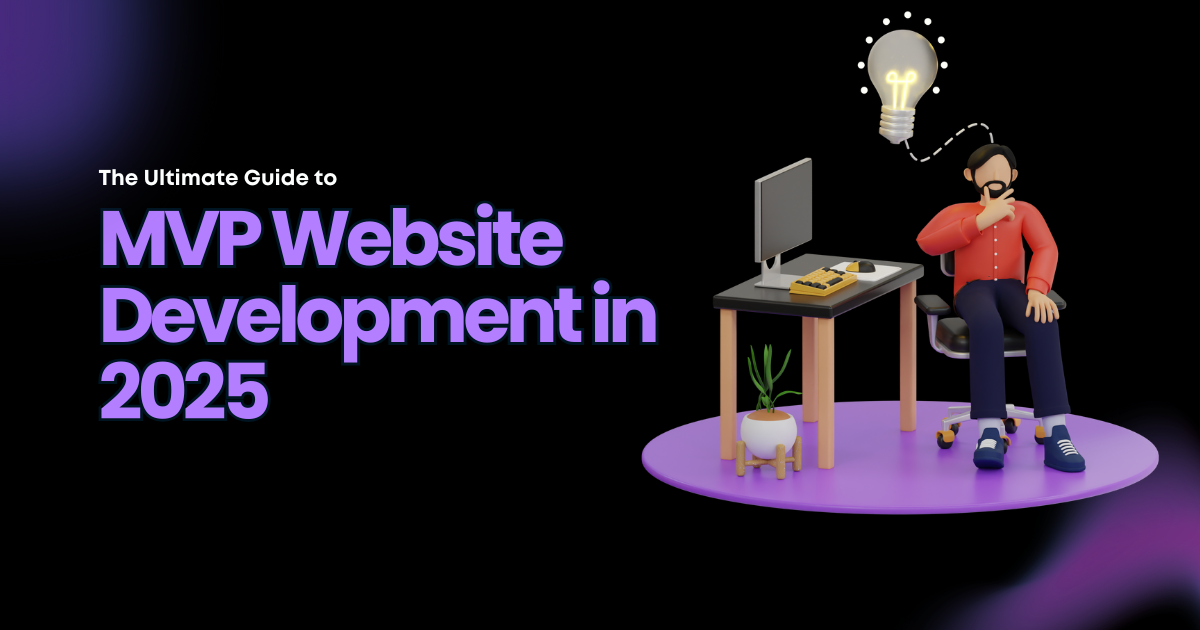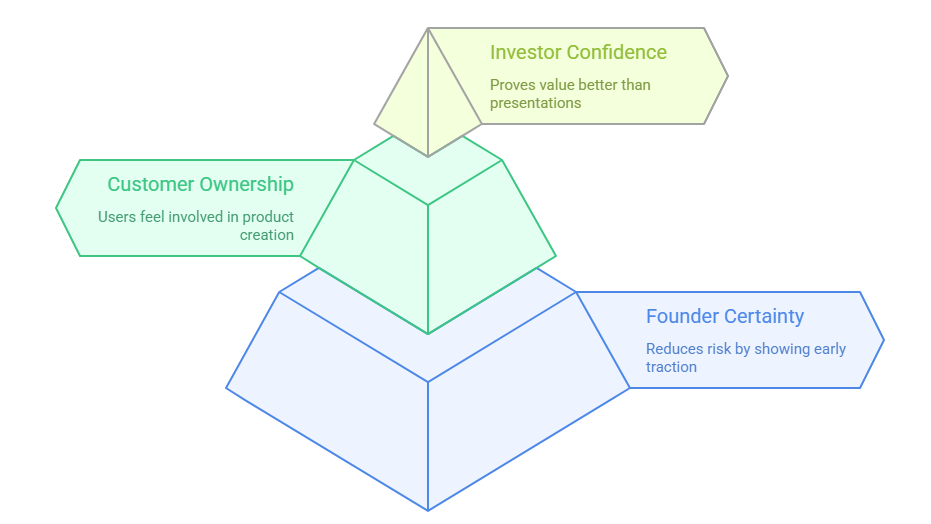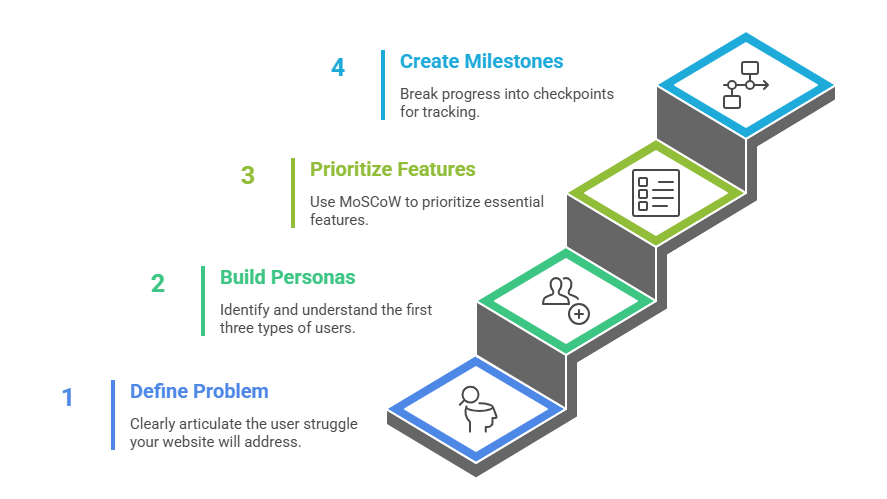
Every founder starts with an idea that feels undeniable. The hard part is proving whether users see the value too. In 2025, MVP website development has become the most effective way to make that proof real.
Industry numbers reinforce this shift. According to CB Insights, 42% of startups fail due to poor product-market fit. Moreover, a recent global study highlighted just how many startups credited their MVP launch with saving them from wasting resources. These numbers reveal why MVP websites have become a preferred first step.
The psychology behind their popularity is powerful. For founders, launching a website early creates clarity and evidence. For customers, engaging with a brand at its earliest stage feels like co-ownership of the journey. This shared experience makes the relationship stronger from day one.
Reid Hoffman, co-founder of LinkedIn, summed this up well: “If you are not embarrassed by the first version of your product, you’ve launched too late.” MVP websites carry that truth into practice by giving founders something real to measure against, not a guess on a whiteboard.
Why MVP Websites are Popular in 2025
The surge of MVP website development in 2025 comes from both data and psychology. Startups are operating in an environment where speed to market matters more than ever. According to Crunchbase, 53% of early-stage investors now ask for a live MVP before committing funds. At the same time, customers are showing preference for brands they can shape.

Why the popularity has grown:
● Founder Psychology: Building an MVP website creates certainty in a world of risk. Founders see early traction and adjust course quickly.
● Customer Psychology: Users enjoy early access and the sense that they are helping create a product. This feeling of ownership deepens brand loyalty.
● Investor Psychology: Traction, even in small numbers, speaks louder than pitch decks. A live MVP website proves more than a slide presentation ever could.
MVP websites succeed because they serve all three audiences at once.
What is an MVP in the Context of a Website?
An MVP website is a working product that highlights your idea’s most valuable feature. It is functional enough to deliver value and gather feedback, yet focused enough to build quickly.
This is distinct from a one-page teaser or a full product. A landing page may only capture interest through signups. A full web platform may overwhelm budgets and timelines before validation. The MVP website balances both.
Key traits of an MVP website:
● Users can perform the essential action your idea is built around.
● Founders can track whether the problem being solved matters in practice.
● Development teams can evolve quickly without waiting for months of build cycles.
For SaaS platforms, service marketplaces, and e-commerce sites, this version becomes the most direct way to validate demand.
MVP Website vs. Landing Page vs. Full Website
Many founders confuse MVP websites with other formats. Here’s a simple comparison to bring clarity:
| Feature | Landing Page | MVP Website | Full Website |
| Purpose | Capture early interest | Validate idea with core functionality | Deliver complete product experience |
| Scope | One or two static pages | Limited but functional features | Fully built features and integrations |
| Example | Email sign-up for waitlist | Checkout flow with 1–2 products | Marketplace with hundreds of products |
| Feedback | Interest only | Behavioral data + early revenue | Long-term growth data |
This table shows why MVP website development is the middle ground. It tests behavior, not just curiosity, while avoiding the heavy lift of a full-scale build.
The Core Principle: The Lean Development Process
MVP website development is guided by the lean development process. Its foundation is the Build–Measure–Learn loop:
● Build: Launch a minimal version with core functionality.
● Measure: Observe how users behave. Where do they click? Where do they leave? What excites them?
● Learn: Refine based on patterns, not assumptions.
Checklist for applying lean development to websites:
● Keep the homepage focused on the core value proposition.
● Simplify the navigation to highlight primary actions.
● Track metrics like bounce rate, sign-up conversion, and cart completion.
● Run usability sessions with a small group to validate early impressions.
Eric Ries, who pioneered this methodology, wrote: “The only way to win is to learn faster than anyone else.” Websites give founders this speed, with analytics that provide answers almost instantly.
Your Strategic Blueprint: Creating a Minimum Viable Product Roadmap
A minimum viable product roadmap provides direction and discipline. Without an effective MVP launch strategy in place, MVP websites risk becoming too scattered or feature-heavy.

What to include in a strong roadmap:
1. Define the Problem Clearly
What is the user struggle your website will address? Put it into one sentence.
2. Build User Personas
Identify the first three types of users. For example, an MVP job board may target recruiters, freelancers, and small businesses.
3. Prioritize Features with MoSCoW
● Must-have: Core action like posting a listing.
● Should-have: Filters or search.
● Could-have: Social sharing.
● Won’t-have (for now): Personalized recommendations.
4. Create Milestones
Break progress into checkpoints. Example: Week 2 – working homepage, Week 4 – functional sign-up flow, Week 6 – first feedback review.
This roadmap becomes a living guide. It reassures investors, keeps teams aligned, and ensures the build serves strategy rather than drifting into scope creep.
How to Create MVP Website: A 6-Step Process
When founders ask us how to create MVP website projects, we follow a step-by-step process.
Step 1: Market Research & Defining Core Functionality
● Study existing websites in the niche.
● Collect feedback from early potential users.
● Define one central use case to validate.
Step 2: Crafting the MVP Requirements Document
The MVP requirements document lays the foundation. It includes:
● Functional features (sign-up, product display, checkout).
● User stories (e.g., “As a visitor, I want to sign up in two clicks”).
● Technical notes (hosting plan, CMS, security requirements).
Step 3: UI/UX Design & Prototyping
● Build wireframes for homepage, signup, and action flow.
● Test prototypes with a small group.
● Focus on clarity and intuitive flow.
Step 4: Technology Stack Selection
● Decide between CMS options (WordPress, Webflow) or frameworks (Next.js, React).
● Choose hosting that supports scale without complexity.
● Keep integrations simple but reliable.
Step 5: Agile Development Sprints
● Break work into two-week increments.
● Deliver a functional slice in each sprint.
● Collect feedback continuously.
Step 6: Testing, Deployment, and Feedback Collection
● Test across multiple devices and browsers.
● Use analytics tools like Hotjar or GA4 for behavioral tracking.
● Gather qualitative feedback through surveys or interviews.
Common Mistakes in MVP Website Development
Even with a clear process, founders make recurring mistakes when working on MVP websites:
● Overloading Features: Adding too much too soon slows launch and dilutes learning.
● Ignoring Analytics: Without early tracking tools, valuable user insights go to waste.
● Weak MVP Requirements Document: Ambiguous documentation creates confusion across teams.
● Neglecting UX Design: Minimal does not mean clumsy; MVP websites still need intuitive flow.
● No Iteration Plan: Launching without a cycle for improvement leaves the website stagnant.
Avoiding these mistakes when planning how to create MVP website ensures that development delivers learning, not waste.
Real-World MVP Website Examples That Succeeded
Seeing MVP website examples illustrates how simple beginnings create lasting companies. Let’s look at a few we know and love:
Notion (Ivan Zhao, Simon Last)
When Ivan Zhao and Simon Last started Notion, they didn’t chase feature overload. Instead, they leaned on the philosophy behind MVP website development: release something small, usable, and customizable. Their first iteration let users create simple web pages and documents. It wasn’t perfect, but it was live, and that made all the difference.
Direct feedback quickly revealed usability gaps and tech stack limitations. Rather than pushing forward blindly, the team reworked the foundation. The payoff came in 2016, when Notion’s website updates and rapid user-driven iterations earned them Product Hunt’s #1 Product of the Day. That moment put them on the map.
What you can learn: Launch early, even if it feels incomplete. Real feedback will highlight what matters. A strong minimum viable product roadmap should leave space for pivots based on user needs, not founder assumptions.
Canva (Melanie Perkins, Cliff Obrecht)
Before Canva became a household name, Melanie Perkins and Cliff Obrecht had spent years hearing “no” from investors. Instead of waiting for funding, they built an early version of Canva that ran directly in the browser. The first MVP website wasn’t flashy, right? But it was functional, letting everyday people design graphics without expensive tools.
By validating demand through actual usage, Perkins refined the product around what users loved most. Tracking metrics like account sign-ups and engagement informed every tweak. Those early lessons shaped Canva into one of the most widely used design platforms today.
What you can learn: You don’t need capital to begin. If you’re figuring out how to create an MVP website, focus on getting a usable version into people’s hands. Watching how they use it will teach you more than any pitch meeting.
Zapier (Wade Foster, Bryan Helmig, Mike Knoop)
Zapier’s story shows the power of speed. Wade Foster, Bryan Helmig, and Mike Knoop built their first automation prototype in just two days at Startup Weekend. The team then launched a stripped-down beta website, inviting niche online communities to try it out.
Instead of giving it away for free, they charged $100 for early access. That move turned users into invested partners, ensuring feedback came from people who truly cared. Every iteration of the MVP was guided by customer insights, which made scaling far smoother later.
What you can learn: Not all MVP website examples are free. Even small, paid betas can reveal whether customers see enough value to spend money. Use focused landing pages and online communities to test willingness to pay before committing to large builds.
Each example reveals the same truth: MVP websites succeed when they focus on validation that is true to them.
Checklist: Is Your MVP Website Ready to Launch?
Before you push your MVP website live, use this quick launch checklist:
Technical Readiness
● Website loads under 3 seconds.
● Responsive across desktop and mobile.
● Core flows tested (sign-up, checkout, form submissions).
Business Readiness
● Clear CTA is visible above the fold.
● MVP requirements document updated post-build.
● Analytics tools installed (GA4, Hotjar, Mixpanel).
User Readiness
● Copy explains the core value in one sentence.
● Navigation feels simple and intuitive.
● Early trust signals visible (testimonials, secure checkout, contact info).
This is an essential step when wondering how to create MVP website. An MVP website that checks these boxes is launch-ready. How is that for simple assessment!
Additional Best Practices for MVP Website Development
Beyond the core steps, successful founders often follow certain principles.
● Design for Scalability: While the MVP is small, choose a stack that allows future growth.
● Use Analytics Early: Install tools like Google Analytics and heatmaps from day one.
● Prioritize Accessibility: Even a minimal website must be usable across devices and for diverse audiences.
● Keep Documentation Alive: Update the MVP requirements document with every sprint to reflect reality.
● Plan Iteration Cycles: Treat every launch as the start of the next version.
The Future of MVP Websites in 2025 and Beyond
The future of MVP website development is shaped by new tools and expectations:
● AI Prototyping: Platforms are generating wireframes and content drafts in hours.
● No-Code Development: Tools like Webflow and Bubble speed up early iterations.
● Personalized MVPs: Early websites now test personalized experiences, not just static features.
● Instant Analytics: Real-time feedback tools allow changes almost instantly.
● Global Reach: Even small MVPs launch globally thanks to cloud hosting and translation tech.
This evolution means founders can validate faster and more accurately than ever before.
FAQs
What is MVP website development?
It is the process of creating a functional website with core features only, designed to validate ideas with real users before investing in a full build.
How do I know which features to include in an MVP website?
Use your minimum viable product roadmap and prioritize features with frameworks like MoSCoW (must-have, should-have, could-have, won’t-have).
How long does it take to build an MVP website?
Depending on scope, it ranges from 4–6 weeks for simple sites to 12+ weeks for complex MVP website development.
What are some famous MVP website examples?
Zappos, Buffer, and Airbnb all began as simple websites that validated demand before scaling.
Why should I work with a professional team for MVP website development?
Experienced teams bring structured processes, reduce rework, and help founders collect the right data to grow.
MVP Development Takeaways
MVP website development has become the foundation of how startups validate ideas in 2025. Guided by the lean development process, powered by a clear minimum viable product roadmap, and supported by a strong MVP requirements document, founders can build smarter websites that attract real users early.
At Enacton, we have worked with founders across SaaS, e-commerce, and service industries to transform visions into live MVP websites. Each project we take on is approached with the same principle: deliver clarity, generate feedback, and create momentum.
Ready to start your journey? Partner with us for MVP website development that turns your idea into a website people can use, test, and love from the start.
Why Work with Enacton?
At Enacton, we specialize in MVP website development for startups across SaaS, e-commerce, and service niches. What sets us apart:
● Proven Experience: Multiple MVP websites launched for clients across industries.
● Structured Process: From MVP requirements document drafting to agile sprints, our methods are tested.
● Scalable Builds: Websites we create as MVPs evolve seamlessly into full-scale platforms.
● Client-Centric Approach: We treat every MVP as the first chapter of your growth story.
Building an MVP website is about more than code. It is about speed, clarity, and validation. Partner with Enacton to turn your vision into traction
